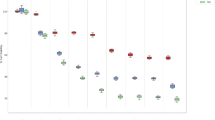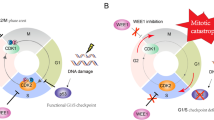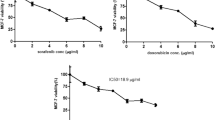Abstract
The present study investigates the effect of afatinib on the growth, induction of apoptosis in RB116 cells, and reduction of carcinoma growth in the mice transplanted with RB116 cells. The results from MTT assay revealed that afatinib inhibited the growth of RB116 cells in a dose-dependent manner. Proliferation of RB116 cells was reduced to 64 % on treatment with 200 μM concentration of afatinib after 48 h. Afatinib treatment of RB116 cells at 200 μM concentration induced apoptosis and necrosis in 49.7 and 9.4 %, respectively, after 48 h. In the RB116-transplanted mice, treatment with afatinib at 10-mg/kg doses for 45 days caused a significant (p < 0.005) reduction in the tumor volume compared to the control group. The tissue lysates of the mice containing RB116 transplant showed a significant decrease in the expressions of Ki67 and p53 in the afatinib treatment group after 45 days. However, the expression of caspase-3 was increased and of Bcl-2 remained unaltered on treatment with afatinib. Measurement of the body weight of afatinib-treated animals showed no reduction during the study. Thus, afatinib can be of therapeutic value for the treatment of retinoblastoma.





Similar content being viewed by others
References
Albert DM. Historic review of retinoblastoma. Ophthalmology. 1987;94:654–62.
Shields JA, Shields CL. Current management of retinoblastoma. Mayo Clin Proc. 1994;69:50–6.
Bishop JO, Madsen EC. Retinoblastoma; review of the current status. Surv Ophthalmol. 1975;19:342–66.
Yanagisawa T. Systemic chemotherapy as a new conservative treatment for intraocular retinoblastoma. Int J Clin Oncol. 2004;9:13–24.
Rodriguez-Galindo C, Wilson MW, Haik BG, Merchant TE, Billups CA, Shaha N, et al. Treatment of intraocular retinoblastoma with vincristine and carboplatin. J Clin Oncol. 2003;21:2019–25.
Seshacharyulu P, Ponnusamy MP, Haridas D, Jain M, Ganti AK, Batra SK. Targeting the EGFR signaling pathway in cancer therapy. Expert Opin Ther Targets. 2012;16:15–31.
Zhang H, Berezov A, Wang Q, et al. ErbB receptors: from oncogenes to targeted cancer therapies. J Clin Invest. 2007;117:2051–8.
Yarden Y, Sliwkowski MX. Untangling the ErbB signalling network. Nat Rev Mol Cell Biol. 2001;2:127–37.
Li D, Ambrogio L, Shimamura T, et al. BIBW2992, an irreversible EGFR/HER2 inhibitor highly effective in preclinical lung cancer models. Oncogene. 2008;27:4702–11.
Harbeck N, Solca F, Gauler TC. Preclinical and clinical development of afatinib: a focus on breast cancer and squamous cell carcinoma of the head and neck. Future Oncol. 2014;10:21–40.
Tsai YC, Yeh CH, Tzen KY, Ho PY, Tuan TF, Pu YS, et al. Targeting epidermal growth factor receptor/human epidermal growth factor receptor 2 signalling pathway by a dual receptor tyrosine kinase inhibitor afatinib for radiosensitisation in murine bladder carcinoma. Eur J Cancer. 2013;49:1458–66.
Quesnelle KM, Grandis JR. Dual kinase inhibition of EGFR and HER2 overcomes resistance to cetuximab in a novel in vivo model of acquired cetuximab resistance. Clinical Cancer Research. 2011;17:5935–44.
Greulich H, Kaplan B, Mertins P, Chen TH, Tanaka KE, Yun CH, et al. Functional analysis of receptor tyrosine kinase mutations in lung cancer identifies oncogenic extracellular domain mutations of ErbB2. Proc Natl Acad Sci USA. 2012;109:14476–81.
Cardillo MR, Castagna G, Memeo L, De Bernardinis E, Di Silverio F. Epidermal growth factor receptor, MUC-1 and MUC-2 in bladder cancer. J Exp Clin Cancer Res. 2000;19:225–33.
Caner V, Turk NS, Duzcan F, et al. No strong association between HER-2/neu protein overexpression and gene amplification in high-grade invasive urothelial carcinomas. Pathol Oncol Res. 2008;14:261–6.
Kiyoshima K, Oda Y, Kinukawa N, Naito S, Tsuneyoshi M. Overexpression of laminin-5 gamma2 chain and its prognostic significance in urothelial carcinoma of urinary bladder: association with expression of cyclooxygenase 2, epidermal growth factor receptor [corrected] and human epidermal growth factor receptor [corrected] 2. Hum Pathol. 2005;36:522–30.
Mori H, Honda K, Ishida R, Nohira T, Tomoda A. Antitumor activity of 2-amino-4,4α-dihydro-4α,7-dimethyl-3H- phenoxazine-3-one against Meth A tumor transplanted into BALB/c mice. Anticancer Drugs. 2000;11:653–7.
Shimamoto T, Tomoda A, Ishida R, Ohyashiki K. Antitumor effect of a novel derivative on human leukemia cell lines in vivo and in vitro. Clin Cancer Res. 2001;7:704–8.
Koshibu-Koizumi J, Akazawa M, Iwamoto T, Takasaki M, Mizuno F, Kobayashi R, et al. Antitumor activity of a phenoxazine compound, 2-amino-4,4α-dihydro- 4α,7-dimethyl-3H-phenoxazine-3-one against human B cell and T cell lymphoblastoid cell lines: induction of mixed types of cell death apoptosis and necrosis. J Cancer Res Clin Oncol. 2002;128:363–8.
Healy E, Angus B, Lawrence CM, Rees JL. Prognostic value of Ki67 antigen expression in basal cell carcinomas. Br J Dermatol. 1995;133:737–41.
Lustosa SA, Logullo A, Artigiani R, Saad SS, Goldenberg A, Matos D. Analysis of the correlation between p53 and Bcl-2 expression with staging and prognosis of the colorectal adenocarcinoma. Acta Cir Bras. 2005;20:353–7.
Author information
Authors and Affiliations
Corresponding author
Rights and permissions
About this article
Cite this article
Zhan, Wj., Zhu, Jf. & Wang, Lm. Inhibition of proliferation and induction of apoptosis in RB116 retinoblastoma cells by afatinib treatment. Tumor Biol. 37, 9249–9254 (2016). https://doi.org/10.1007/s13277-015-4768-1
Received:
Accepted:
Published:
Issue Date:
DOI: https://doi.org/10.1007/s13277-015-4768-1




